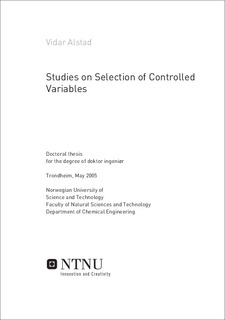| dc.contributor.author | Alstad, Vidar | nb_NO |
| dc.date.accessioned | 2014-12-19T13:22:47Z | |
| dc.date.available | 2014-12-19T13:22:47Z | |
| dc.date.created | 2007-11-22 | nb_NO |
| dc.date.issued | 2005 | nb_NO |
| dc.identifier | 123005 | nb_NO |
| dc.identifier.isbn | 82-471-7057-4 | nb_NO |
| dc.identifier.uri | http://hdl.handle.net/11250/248064 | |
| dc.description.abstract | Increased competition in the process industries requires optimal operation and better utilization of raw materials and energy. One strategy for achieving improved production is to use real-time optimization (RTO), based on measured disturbances and process measurements. The optimal solution is usually implemented by updating setpoints to the control system which task is to keep the controlled variables at the setpoint. Thus, the selection of controlled variables integrates the optimization and the control layer.
Selecting the right controlled variables can be of paramount importance. Many chemical processes are influenced by disturbances that are often not measured and where installing new measurements are not economically viable. Thus, finding controlled variables where the optimal value is insensitive to disturbances could eliminate the need of estimating these disturbances online and would reduce the need of frequent setpoint updates. The use of feedback control introduces implementation errors. It is important to select controlled variables that are insensitive to implementation errors. The "optimal" implementation would be to use a dynamic optimizer which, based on full information of the disturbances and the plant outputs, calculates the optimal inputs. In practice, control systems have a hierarchical structure, where different layers operate on different time scales. Thus, the selection of controlled variables (which links these layers together) is important.
The ideal situation is to have self-optimizing controlled variables where operation remains near-optimal in presence of disturbances and implementation errors using constant setpoints. This work puts emphasis on methods for selecting such self-optimizing controlled variables. We base the selection of controlled variables on an economic measure of the operation. We assume that the setpoints are nominally optimal, and we propose the null space method for selecting controlled variables as a combination of measurements. The selection of the controlled variables is based on the optimal sensitivity matrix from the disturbances to the measurements. This information can easily be provided by using experiments or a model of the plant. The main focus, is to find controlled variables that yield good self-optimizing properties with respect to disturbances. The method uses local information, however, several case studies have shown that the operation is near-optimal in a wider region of the disturbance space.
To generalize the null space method, we propose a method for selecting measurements that minimizes the effect of implementation errors on the economic performance for the resulting control structure. Based on the derivation of the null space method, we propose a simple procedure for finding controlled variables using the null space method. The procedure is split in two: First, we select measurements that are insensitive to measurement error. Second, we combine these measurements to form the self-optimizing control structure.
Further, we discuss how non-optimal nominal points affect the selection of controlled variables for self-optimizing control. We find that the selection of controlled variables is unaffected by non-optimal nominal points, and that the average increase in loss is independent of what we select to control.
Another contribution is to provide several case studies where the null space method is compared with previously proposed methods for selecting controlled variables. The null space method is illustrated on a Petlyuk distillation column for separation of ternary mixtures. We find that the null space method yields a control structure with acceptable steady-state and dynamic performance. Other cases studied are an evaporator process and oil and gas production networks.
Finally, we show that for the Petlyuk distillation column it is energetically optimal to over-fractionate one of the products. This surprising result is discussed and expressions for the possible savings are derived. | nb_NO |
| dc.language | eng | nb_NO |
| dc.publisher | Fakultet for naturvitenskap og teknologi | nb_NO |
| dc.relation.ispartofseries | Doktoravhandlinger ved NTNU, 1503-8181; 2005:91 | nb_NO |
| dc.relation.haspart | Alstad, Vidar. Disturbance discrimination in self-optimizing control. . | nb_NO |
| dc.relation.haspart | Alstad, Vidar. E®ect of non-optimal nominal setpoints on self-optimizing control structures. . | nb_NO |
| dc.relation.haspart | Alstad, Vidar. Dynamics of controlling measurements combinations. . | nb_NO |
| dc.relation.haspart | Alstad, Vidar. Extended null space method. . | nb_NO |
| dc.relation.haspart | Hori, Eduardo S; Skogestad, Sigurd; Alstad, Vidar. Perfect steady-state indirect control. Ind. Eng. Chem. Res.. 44(4): 863-867, 2005. | nb_NO |
| dc.title | Studies on selection of controlled variables | nb_NO |
| dc.type | Doctoral thesis | nb_NO |
| dc.contributor.department | Norges teknisk-naturvitenskapelige universitet, Fakultet for naturvitenskap og teknologi, Institutt for kjemisk prosessteknologi | nb_NO |
